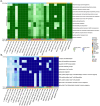This is a preprint.
Integrative transcriptome-based drug repurposing in tuberculosis
- PMID: 40501823
- PMCID: PMC12157595
- DOI: 10.1101/2025.06.02.657296
Integrative transcriptome-based drug repurposing in tuberculosis
Abstract
Tuberculosis (TB) remains the second leading cause of infectious disease mortality worldwide, killing over one million people annually. Rising antibiotic resistance has created an urgent need for host-directed therapeutics (HDTs) - preferably by repurposing existing approved drugs - that modulate host immune responses rather than directly targeting the pathogen. Repurposed therapeutics have been successfully identified for cancer and COVID-19 by finding drugs that reverse disease gene expression patterns (an approach called 'connectivity scoring'), but this approach remains largely unexplored for bacterial infections like TB. The application of transcriptome-based methods to TB faces significant challenges, including dataset heterogeneity across transcriptomics platforms and biological conditions, uncertainty about optimal scoring methods, and lack of systematic approaches to identify robust disease signatures. Here, we developed an integrative computational workflow combining multiple connectivity scoring methods with consensus disease signature construction and used it to systematically identify FDA-approved drugs as promising TB host-directed therapeutics. Our framework integrates six complementary connectivity methods and constructs weighted consensus signatures from 21 TB gene expression datasets spanning microarray and RNA-seq platforms, diverse cell types, and infection conditions. Our approach prioritized 140 high-confidence drug candidates that consistently reverse TB-associated gene expression changes, successfully recovering known HDTs, including statins (atorvastatin, lovastatin, fluvastatin) and vitamin D receptor agonists (calcitriol). We identified promising novel candidates such as niclosamide and tamoxifen, both recently validated in experimental TB models, and revealed enrichment for therapeutically relevant mechanisms, e.g., cholesterol metabolism inhibition and immune modulation pathways. Network analysis of disease-drug interactions identified 10 key bridging genes (including MYD88, RELA, and CXCR2) that represent potential novel druggable targets for TB host-directed therapy. This work establishes transcriptome-based connectivity mapping as a viable approach for systematic HDT discovery in bacterial infections and provides a robust computational framework applicable to other infectious diseases. Our findings offer immediate opportunities for experimental validation of prioritized drug candidates and mechanistic investigation of identified druggable targets in TB pathogenesis.
Figures




Similar articles
-
Cost-effectiveness of using prognostic information to select women with breast cancer for adjuvant systemic therapy.Health Technol Assess. 2006 Sep;10(34):iii-iv, ix-xi, 1-204. doi: 10.3310/hta10340. Health Technol Assess. 2006. PMID: 16959170
-
Rapid molecular tests for tuberculosis and tuberculosis drug resistance: a qualitative evidence synthesis of recipient and provider views.Cochrane Database Syst Rev. 2022 Apr 26;4(4):CD014877. doi: 10.1002/14651858.CD014877.pub2. Cochrane Database Syst Rev. 2022. PMID: 35470432 Free PMC article.
-
Antidepressants for pain management in adults with chronic pain: a network meta-analysis.Health Technol Assess. 2024 Oct;28(62):1-155. doi: 10.3310/MKRT2948. Health Technol Assess. 2024. PMID: 39367772 Free PMC article.
-
Xpert® MTB/RIF assay for extrapulmonary tuberculosis and rifampicin resistance.Cochrane Database Syst Rev. 2018 Aug 27;8(8):CD012768. doi: 10.1002/14651858.CD012768.pub2. Cochrane Database Syst Rev. 2018. Update in: Cochrane Database Syst Rev. 2021 Jan 15;1:CD012768. doi: 10.1002/14651858.CD012768.pub3. PMID: 30148542 Free PMC article. Updated.
-
Systemic pharmacological treatments for chronic plaque psoriasis: a network meta-analysis.Cochrane Database Syst Rev. 2021 Apr 19;4(4):CD011535. doi: 10.1002/14651858.CD011535.pub4. Cochrane Database Syst Rev. 2021. Update in: Cochrane Database Syst Rev. 2022 May 23;5:CD011535. doi: 10.1002/14651858.CD011535.pub5. PMID: 33871055 Free PMC article. Updated.
References
-
- World Health Organization, “Global Tuberculosis Report 2023.” World Health Organization, 2023. [Online]. Available: https://www.who.int/publications/i/item/9789240078482
Publication types
Grants and funding
LinkOut - more resources
Full Text Sources
